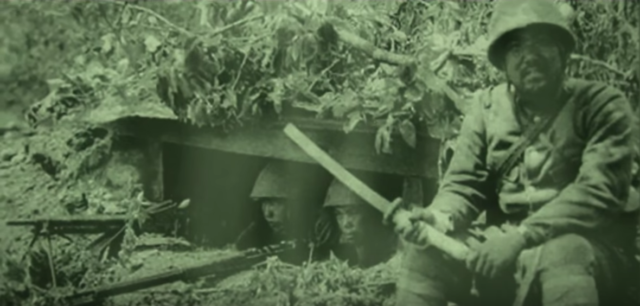Memories of a Forgotten War is Utpal Borpujari’s new documentary about the failed Japanese invasion of India during World War II. It’s part oral history and part archival footage set in 1944. Japanese troops advanced into India from Burma and were repelled by Allied forces during the Battle of Kohima and the Battle of Imphal. Around 168,000 people died during the conflict. Disease actually killed more Japanese troops than the fighting. It marked a turning point for the Axis in WWII.
Borpujari shot his documentary over two-and-a-half years in Delhi, Mizoram, Manipur, Nagaland, Japan and the UK. It includes interviews with men who fought in the trenches and people who witnessed the conflict. It was produced by Subimal Bhattacharjee.
The 48-year-old documentarian found reminders of the Japanese campaign still existing in the towns and hills of Manipur and Nagaland. Families have on display live shells they’ve uncovered; villagers use gunpowder from unexploded ammunition to make small bombs which are used to stun fish. They have helmets, water bottles, and cutlery that they have found. One villager lost an arm while trying to dismantle a live bomb. The temple has a pair of bells made from a shell cut in two.
War tourism is thriving in Manipur and, to a lesser extent, Nagaland. Veterans and curious Indians visit cemeteries and memorials.
“There have been films made on these battles, but they are mostly about military strategy. However, nobody has tried to capture these stories in a film format. The idea was to record the memories and preserve them. The youngest veteran was 91, and the oldest was 96. Since the time I made the film, a few of them have passed away, so it was important to record these memories,” said Borpujari.
There are vivid accounts in the film of a terrifying time. “Twelve o’clock, I could hear a deep roaring in the sky, deep roaring of sounds,” says a resident of Chingambam Mandap in Imphal. This is one of the places bombed by the Japanese. One older member of the village recalled that the Japanese did not mistreat the villagers in any way, but the dogs would not stop barking at them.
Borpujari interviewed several soldiers from both sides. He went to Japan and met with Japanese and British soldiers at a joint commemoration ceremony of the Battle of Kohima. The Japanese have a difficult time talking about an extremely embarrassing topic in their country.

They speak eloquently and touchingly about the horrors of war. A British soldier remembers picking the remains of Gurkha victims off his bedding, which were killed in an explosion. He also remembers sucking on rock salt which was in short supply at the time. The differences in race between the Indian, British and American soldiers disappeared in a moment when they stood in a circle and chewed on the salt that was passed around. “When it came to the crunch, we were all human, we lacked salt,” the former soldier says.
Borpujari filmed 35 hours of interviews which were trimmed to a 330-minute version of the documentary and then chopped further down to 109 minutes. This style of filmmaking, balancing location shooting with multiple interviews, can be ungainly. The director tried to avoid that tendency by conducting the interviews as informal conversations. “The format was not sit-down; most of the people interviewed are sharing their memories as they would with a family member,” the filmmaker said. “I wanted the film to have the feel of an oral history project. I wanted the interviews to have the feeling of somebody telling the story to somebody else.”
Challenges included the logistics of travelling to so many different locations, tracking down the right people to interview and translating myriad languages and dialects.
Conversations in the film include discussions about the role of the Indian National Army, which was fighting with the Japanese. In Moirang town in Manipur, the thatched hut used by the INA for their headquarters has been preserved, including the holes in the roof from firing. The film also shows the Renkoji Buddhist temple in Tokyo where INA’s founder, Subhash Chandra Bose, are worshipped. Borpujari even finds a local manga, Storm of India, which is dedicated to Bose’s exploits, The Reel reported.
“From one side, you have the Japanese worshipping Netaji in a temple and from the other point of view, the British soldier who says that it is sad that the INA was fighting Indian soldiers,” Borpujari said. “We never get to hear this here, since we hero-worship the INA.”
One of many emotional moments in the film occurs when British and Japanese soldiers at the commemoration ceremony embrace and cry. The film is very fair, treating the Japanese soldiers with the same respect that is shown the Allied soldiers.
